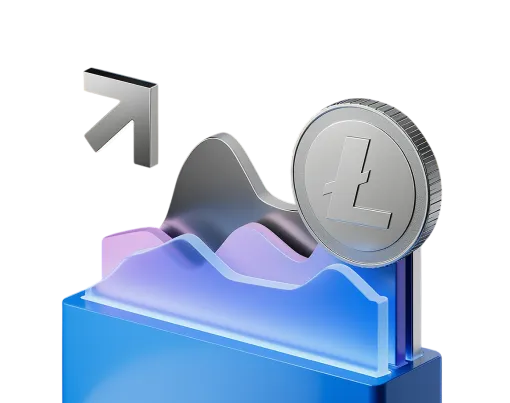What is Litecoin Hashrate & Why is it important?

Hashrate is a crucial metric for proof-of-work blockchains like Litecoin. It serves as a key indicator of the network's security and overall health.
This article explores the details of hashrate and its significance for the Litecoin blockchain.
What is Hashrate in Cryptocurrency?
Hashrate measures the total computational power miners use to validate transactions and secure a blockchain network. It represents the combined processing power of all participants mining on the network.
Hashrate is calculated in hashes per second (h/s) and often expressed in larger units:
- Kilo hash (KH/s): One thousand hashes per second
- Mega hash (MH/s): One million hashes per second
- Giga hash (GH/s): One billion hashes per second
- Tera hash (TH/s): One trillion hashes per second
- Peta hash (PH/s): One quadrillion hashes per second
- Exa hash (EH/s): One quintillion hashes per second
- Zetta hash (ZH/s): One sextillion hashes per second
- Yotta hash (YH/s): One septillion hashes per second
Litecoin Hashrate: A Closer Look
The Litecoin hashrate refers to the total computing power dedicated to processing transactions and securing the Litecoin network.
For years, Litecoin's hashrate was measured in terahashes per second (TH/s). In mid-2023, it surpassed the one petahash per second (1 PH/s) milestone for the first time. This achievement signaled a significant increase in mining participation, computing power, and the overall security of the Litecoin network.
Since then, the hashrate has maintained these higher levels, reflecting intensified competition among miners and sustained confidence in the long-term prospects of LTC. This growth is likely fueled by network upgrades and the increasing adoption of the Litecoin blockchain.
Over the last few years, Litecoin's hashrate has shown a steady upward trend, rising from approximately 400 TH/s in early 2022 to consistently maintaining levels near 1 PH/s. This sustained growth is a positive indicator for the health of the Litecoin blockchain.
Why the Litecoin Hashrate Is Important
Litecoin operates on a proof-of-work consensus mechanism, relying on miners to process transactions and secure the network. The hashrate is fundamental to the network's efficiency and security for several reasons.
Network Security
A high hashrate makes it more difficult for malicious actors to gain majority control of the network's computational power. The higher the hashrate, the more secure the network is against potential attacks, such as a 51% attack.
Network Health
A stable or rising hashrate indicates a growing and healthy network. It suggests increasing mining participation and confidence, which contribute to the overall stability and growth of the blockchain.
Mining Difficulty
Mining difficulty is a measure of how hard it is to generate a valid hash for a new block. Blockchains automatically adjust this difficulty to maintain a consistent block time. When the hashrate increases, the mining difficulty also increases; when the hashrate falls, the difficulty decreases.
Mining Profitability
A rising hashrate often leads to increased competition and mining difficulty, which can reduce the rewards for individual miners. However, other factors also affect profitability, including the coin's price, block rewards, and transaction fees.
Potential Price Impact
While hashrate does not directly determine the price of LTC, a rising hashrate indicates greater network activity and security. This can attract more miners and investors, potentially driving up demand and positively influencing the price. It is important to remember that many other factors, such as market sentiment, adoption rates, and macroeconomic conditions, also affect a cryptocurrency's price.
Litecoin Hashrate vs. Bitcoin Hashrate
Hashrate is critical to the stability and security of both the Litecoin and Bitcoin blockchains, as they both use a proof-of-work consensus mechanism.
Bitcoin's hashrate is substantially higher than Litecoin's, primarily due to its hashing algorithm and larger scale of mining participation. Bitcoin uses the SHA-256 algorithm, which requires specialized hardware like Application-Specific Integrated Circuits (ASICs) that generate extremely high hashrates.
Litecoin, on the other hand, uses the Scrypt hashing algorithm. While originally designed to be mined with less resource-intensive hardware like Graphics Processing Units (GPUs), ASICs have since been developed for Scrypt as well.
Currently, Bitcoin's hashrate is over 600 EH/s and has occasionally surpassed one zettahash per second (1 ZH/s). This makes Bitcoin's hashrate hundreds of thousands of times higher than Litecoin's. This vast difference is attributed to factors like Bitcoin's higher price, greater mining profitability, and widespread institutional adoption, making Bitcoin the most secure blockchain network.
How to Check the Litecoin Hashrate
The Litecoin hashrate is publicly available information that can be found on various platforms. You can check it on Litecoin block explorers like Blockchair and Tokenview. Data is also available on specialized websites such as BitInfoCharts and CoinWarz, which track mining statistics. Additionally, many Litecoin mining pools, including LitecoinPool.org and ProHashing, display the network's current hashrate.
What Affects Litecoin's Hashrate?
Several factors influence Litecoin's hashrate. The type of mining hardware is a primary driver, as powerful ASICs produce significantly more hashes per second than older hardware. The market price of LTC is also crucial; a higher price incentivizes more miners to join the network, boosting the hashrate. Conversely, a sustained price drop can discourage participation. Energy costs are another major factor, as mining is an energy-intensive process, and lower electricity prices can attract more miners. The network's mining difficulty also plays a role, as increasing difficulty may deter miners with limited resources. Finally, the regulatory climate can have an impact, with favorable government policies encouraging mining activity while restrictive laws may dissuade it.
What Happens if the Hashrate Drops Too Low?
A declining hashrate indicates a reduction in the computing power securing the network. This may be due to fewer miners participating or a downgrade in mining hardware. A significant drop suggests the blockchain is becoming less decentralized, increasing the risk of malicious attacks.
If the hashrate drops too low, it can negatively affect the network's performance. It may lead to slower transaction confirmation times and increased block creation times. This can erode confidence among traders and investors, potentially causing the market price to fall. In extreme cases, cryptocurrency exchanges might limit trading or delist the asset to protect users from the risks associated with an insecure network.
Ultimately, a persistently declining hashrate signals that a blockchain is becoming less stable and secure, which can hinder its adoption and long-term viability.
Conclusion
Hashrate is a fundamental measure of a blockchain's security and efficiency. A higher hashrate means the network has a greater capacity to process transactions and is more resilient against potential attacks.
The significant rise in Litecoin's hashrate in recent years signifies growing confidence in its security and future outlook. Understanding hashrate is essential for miners, traders, and investors to accurately assess the overall health and security of the Litecoin blockchain.

 Roman Klochko
Roman Klochko